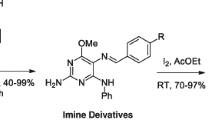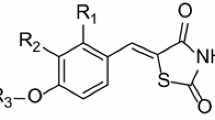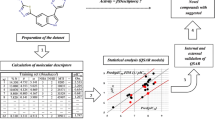Abstract
A series of α-N-heterocyclic carboxaldehyde thiosemicarbazones derivatives exhibit anticancer activity by inhibiting ribonucleotide reductase (RNR) enzyme was considered for the present computational study. The validated quantitative structure activity relationship (QSAR) models constructed with vsurf (HB7, WP7 and DW23) and molar refractivity (SMR_VSA5) descriptors yielded the cross-validated correlation coefficient of >0.6, shows that the models have sufficient predictive ability. The SMR_VSA5 descriptor is the main contributor for the activity prediction in all models, which measure the steric factors and bulkiness of the given molecules. The negative contribution of the molar refractivity descriptor shows that the molecular volume should be low with its polar properties. The vsurf descriptors are dependent on the structure connectivity and conformation (dimensions are measured in Å) which are useful in surface property prediction. The vsurf descriptors reveal that the surface polarity, hydrogen bond donor properties and hydrophilic contact surface of the molecules are important for the activity. The pharmacophore analysis results obtained from this study shows that the distance between the aromatic/hydrophobic and the PiN sites to the H-bond donor and acceptor groups should be connected with almost the same distance for significant RNR inhibitory activity.




Similar content being viewed by others
References
Alexander G, Alexander T (2002) Beware of Q2. J Mol Graphs Model 20:269–276
Balaji S, Karthikeyan C, Moorthy NSHN, Trivedi P (2004) QSAR modelling of HIV-1 reverse transcriptase inhibition by benzoxazinones using a combination of P_VSA and pharmacophore feature descriptors. Bioorg Med Chem Lett 14:6089–6094
Cerqueira NMFSA, Pereira S, Fernandes PA, Ramos MJ (2005) Overview of ribonucleotide reductase inhibitors: an appealing target in anti-tumour therapy. Curr Med Chem 12(11):1283–1294
Cerqueira NMFSA, Fernandes PA, Ramos MJ (2006) Enzyme ribonucleotide reductase: unraveling an enigmatic paradigm of enzyme inhibition by furanone derivatives. J Phys Chem B 110(42):21272–21281
Cerqueira NMFSA, Fernandes PA, Ramos MJ (2007a) Ribonucleotide reductase: a critical enzyme for cancer chemotherapy and antiviral agents. Recent Pat Anticancer Drug Discov 2:11–29
Cerqueira NMFSA, Fernandes PA, Ramos MJ (2007b) Understanding ribonucleotide reductase inactivation by gemcitabine. Chem Eur J 13(30):8507–8515
Cook RD (1979) Influential observation in linear regression. J Am Stat Assoc 74(365):169–174
Cruciani G, Crivori P, Carrupt PA, Testa B (2000a) Molecular fields in quantitative structure permeation relationships: the Volsurf approach. J Mol Struct: Theochem 503(1–2):17–30
Cruciani G, Pastor M, Guba W (2000b) Volsurf: a new tool for the pharmacokinetic optimization of lead compounds. Eur J Pharm Sci 11(2):S29–S39
Durbin J, Watson GS (1950) Testing for serial correlation in least squares regression. I. Biometrika 37:409–428
Durbin J, Watson GS (1951) Testing for serial correlation in least squares regression II. Biometrika 38:159–179
Fernandes PA, Ramos MJ (2003) Theoretical studies on the mechanism of Inhibition of ribonucleotide reductase by (E)-2′-fluromethylene-2′-deoxycitidine-5′-diphosphate. J Am Chem Soc 125(20):6311–6322
Finch RA, Liu M, Grill SP, Rose WC, Loomis R, Vasquez KM, Cheng Y, Sartorelli AC (2000) Triapine (3-aminopyridine-2-carboxaldehyde-thiosemicarbazone): a potent inhibitor of ribonucleotide reductase activity with broad- spectrum antitumor activity. Biochem Pharmacol 59:983–991
Ishiki HM, do Amaral AT (2009) Three-dimensional quantitative structure activity relationship study of antitumor 2-formylpyridine thiosemicarbazones derivatives as inhibitors of ribonucleotide reductase. QSAR Comb Sci 28:1334–1345
Kolberg M, Strand KR, Graff P, Andersson KK (2004) Structure, function and mechanism of ribonucleotide reductases. Biochimica et Biophysica Acta (BBA) Proteins Proteomics 1699(1–2):1–34
Krishnan K, Prathiba K, Jayaprakash V, Basu A, Nibha M, Zhou B, Hu S, Yen Y (2008) Synthesis and ribonucleotide reductase inhibitory activity of thiosemicarbazone. Bioorg Med Chem Lett 18:6248–6250
Lin A (2002) QuaSAR-descriptors. J Chem Comput Group. http://www.chemcomp.com/Journal_of_CCG/Features/descr.htm
MOE 2007.02 Chemical Computing Group Inc., Montreal, H3A 2R7 Canada, http://www.chemcomp.com
Navarra P, Preziosi P (1999) Hydroxyurea: new insights on an old drug. Crit Rev Oncol Hematol 29:249–255
Norlund P, Reichard P (2006) Ribonucleotide reductase. Annu Rev Biochem 75:681–706
Radivoyevitch T, Kashlan OB, Cooperman BS (2005) Rational polynomial representation of ribonucleotide reductase activity. BMC Biochem 6:8
Raichurkar AV, Kulkarni VM (2003) Understanding the antitumor activity of novel hydroxysemicarbazide derivatives as ribonucleotide reductase inhibitors using CoMFA and CoMSIA. J Med Chem 46:4419–4427
Ren S, Wang R, Komatsu K, Bonaz-Krause P, Zyrianov Y, McKenna EE, Csipke C, Tokes ZA, Lien EJ (2002) Synthesis, biological evaluation and quantitative structure-activity relationship analysis of new Schiff bases of hydroxysemicarbazide as potential antitumor agents. J Med Chem 45:410–419
Robert MO (2007) A caution regarding rules of thumb for variance inflation factors. Qual Quant 41:673–690
Shao J, Zhou B, Chu B, Yen Y (2006) Ribonucleotide reductase inhibitors and future drug design. Curr Cancer Drug Targets 6:409–431
Statistica 8.0 statistical software (2008) StatSoft, Inc, Tulsa, OK, USA
Szekeres T, Fritzer-Szekeres M, Elford HL (1997) The enzyme ribonucleotide reductase: target for antitumor and anti-HIV therapy. Crit Rev Clin Lab Sci 34:503–528
Tsimberidou AM, Alvarado Y, Giles FJ (2002) Evolving role of ribonucleoside reductase inhibitors in hematologic malignancies. Expert Rev Anticancer Ther 2:437–448
Wildman SA, Crippen GM (1999) Prediction of physiochemical parameters by atomic contributions. J Chem Inf Comput Sci 39(5):868–873
Acknowledgment
One of the authors (N.S.H.N. Moorthy) gratefully acknowledges the Foundation of Science and Technology (FCT), Portugal for Postdoctoral Grant (SFRH/BPD/44469/2008).
Author information
Authors and Affiliations
Corresponding author
Rights and permissions
About this article
Cite this article
Moorthy, N.S.H.N., Cerqueira, N.M.F.S.A., Ramos, M.J. et al. QSAR and pharmacophore analysis of thiosemicarbazone derivatives as ribonucleotide reductase inhibitors. Med Chem Res 21, 739–746 (2012). https://doi.org/10.1007/s00044-011-9580-x
Received:
Accepted:
Published:
Issue Date:
DOI: https://doi.org/10.1007/s00044-011-9580-x




